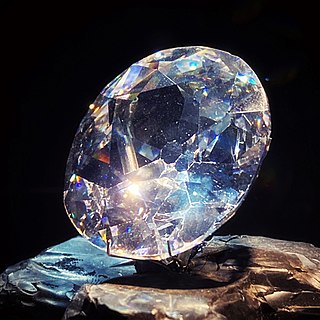
The Koh-i-Noor, also spelt Koh-e-Noor, Kohinoor and Koh-i-Nur, is one of the largest cut diamonds in the world, weighing 105.6 carats (21.12 g). It is part of the Crown Jewels of the United Kingdom. The diamond is currently set in the Crown of Queen Elizabeth The Queen Mother.

The Cullinan Diamond is the largest gem-quality rough diamond ever found, weighing 3,106 carats (621.20 g), discovered at the Premier No.2 mine in Cullinan, South Africa, on 26 January 1905. It was named after Thomas Cullinan, the owner of the mine. In April 1905, it was put on sale in London, but despite considerable interest, it was still unsold after two years. In 1907, the Transvaal Colony government bought the Cullinan and Prime Minister Louis Botha presented it to Edward VII, the British king who reigned over the territory. It was then cut by Joseph Asscher & Co. in Amsterdam.

The Crown Jewels of the United Kingdom, originally the Crown Jewels of England, are a collection of royal ceremonial objects kept in the Jewel House at the Tower of London, which include the coronation regalia and vestments worn by British monarchs.

St Edward's Crown is the coronation crown of the Crown Jewels of the United Kingdom. Named after Saint Edward the Confessor, versions of it have traditionally been used to crown English and British monarchs at their coronations since the 13th century. It is normally on public display in the Jewel House at the Tower of London.

The Imperial State Crown is the state crown of the British monarch. Based on the design of Queen Victoria's Crown of 1838, which had fallen into disrepair, it was made in 1937 for the coronation of King George VI. The crown remains in use today at coronations and State Openings of Parliament. It is adorned with 3,170 precious stones, including the 317-carat (63 g) Cullinan II diamond, St Edward's Sapphire, the Stuart Sapphire, and the Black Prince's Ruby.
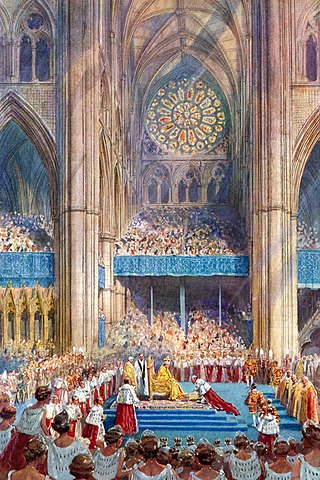
The coronation of the monarch of the United Kingdom is an initiation ceremony in which they are formally invested with regalia and crowned at Westminster Abbey. It corresponds to the coronations that formerly took place in other European monarchies, which have all abandoned coronations in favour of inauguration or enthronement ceremonies. A coronation is a symbolic formality and does not signify the official beginning of the monarch's reign; de jure and de facto his or her reign commences from the moment of the preceding monarch's death or abdication, maintaining legal continuity of the monarchy.

The Coronation Chair, also known as St Edward's Chair or King Edward's Chair, is an ancient wooden chair that is used by British monarchs when they are invested with regalia and crowned at their coronation. The chair was commissioned in 1296 by King Edward I of England to house the Stone of Scone, the symbol of royal authority in Scotland. Since 1308, it has been used at every coronation of English and British Monarchs at Westminster Abbey. The coronation chair is arguably the most valuable and revered piece of furniture in the world. The chair was named after Edward the Confessor, and is currently kept in St George's Chapel at Westminster Abbey, London, and was last used by King Charles the III at his coronation in 2023.

The Diamond Diadem, historically known as the George IV State Diadem, is a diadem that was made in 1820 for King George IV. The diadem has been worn by queens regnant and queens consort in procession to coronations and State Openings of Parliament. It has been featured in paintings and on stamps and currency.
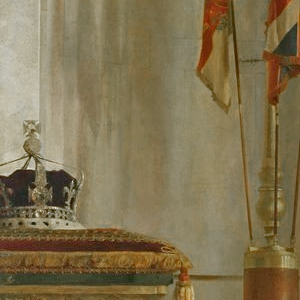
The Crown of Queen Elizabeth The Queen Mother, also known as the Queen Mother's Crown, is the crown made for Queen Elizabeth to wear at her coronation in 1937 and State Openings of Parliament during the reign of her husband, King George VI. The crown was made by Garrard & Co., the Crown Jeweller at the time, and is modelled partly on the design of the Crown of Queen Mary, though it differs by having four half-arches instead of the eight that Queen Mary's Crown originally had. As with Queen Mary's Crown, its arches are detachable at the crosses pattée, allowing it to be worn as a circlet or open crown. It is the only crown for a British king or queen to be made of platinum.
A consort crown is a crown worn by the consort of a monarch for their coronation or on state occasions. Unlike with reigning monarchs, who may inherit one or more crowns for use, consorts sometimes had crowns made uniquely for them and which were worn by no other subsequent consorts.

The Crown of Queen Camilla, known as the Crown of Queen Mary up until January 2025, is a consort crown that is part of the Crown Jewels of the United Kingdom. It was made in 1911 for the coronation of British queen Mary of Teck. Mary thereafter wore it on occasion in circlet form. It was used again, in an altered form, at the coronation of Queen Camilla in 2023.

The State Crown of Mary of Modena is the consort crown made in 1685 for Mary of Modena, queen of England, Scotland and Ireland. It was used by future queens, even by queens regnant until the end of the 18th century.
A half-arch is the piece of gold, silver or platinum, usually decorated with jewels, that links the circlet of a hoop crown to the monde at the top of the crown.

The Crown of Queen Adelaide was the consort crown of the British queen Adelaide of Saxe-Meiningen. It was used at Adelaide's coronation in 1831. It was emptied of its jewels soon afterwards, and has not been worn since. In the late 20th century, it was reacquired for the Royal Collection.

The Small Diamond Crown of Queen Victoria is a miniature imperial and state crown made at the request of Queen Victoria in 1870 to wear over her widow's cap following the death of her husband, Prince Albert. It was perhaps the crown most associated with the queen and is one of the Crown Jewels on public display in the Jewel House at the Tower of London.

Elizabeth II owned a historic collection of jewels – some as monarch and others as a private individual. They are separate from the gems and jewels of the Royal Collection, and from the coronation and state regalia that make up the Crown Jewels.
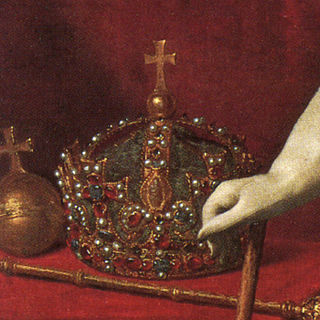
The Tudor Crown was a state crown created in the early 16th century for either Henry VII or Henry VIII, the first Tudor monarchs of England, and destroyed in 1649 during the English Civil War. It was described by the art historian Sir Roy Strong as 'a masterpiece of early Tudor jeweller's art'.
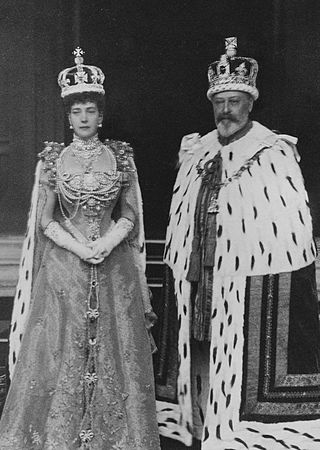
The coronation of Edward VII and his wife, Alexandra, as king and queen of the United Kingdom and the British Dominions took place at Westminster Abbey, London, on 9 August 1902. Originally scheduled for 26 June of that year, the ceremony had been postponed at very short notice, because the King had been taken ill with an abdominal abscess that required immediate surgery. In contrast to the coronation of Queen Victoria, Edward's mother and predecessor, some 64 years earlier, Edward and Alexandra's coronation had been carefully planned as a spectacle reflecting the influence and culture of the British Empire, then at the height of its power, but also as a meaningful religious occasion.

The coronation of George V and his wife, Mary, as king and queen of the United Kingdom and the British Dominions took place at Westminster Abbey, London, on Thursday 22 June 1911. This was the second of four such events held during the 20th century and the last to be attended by royal representatives of the great continental European empires.

















